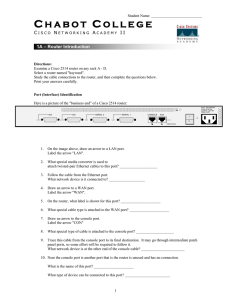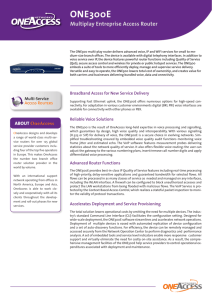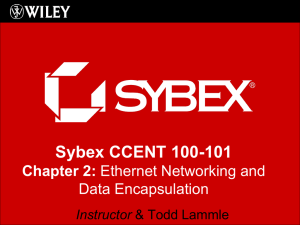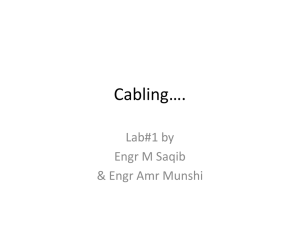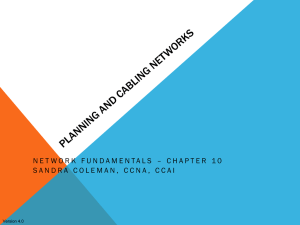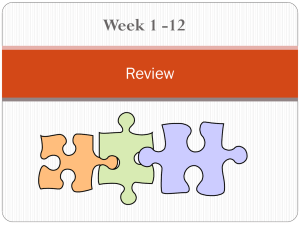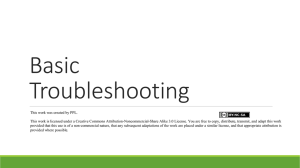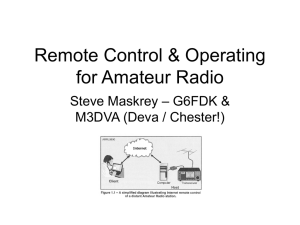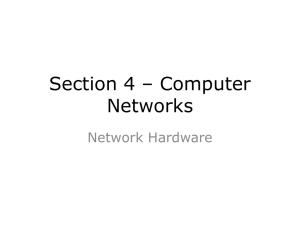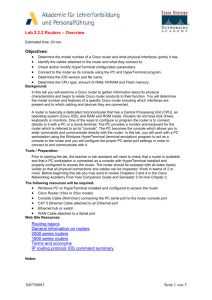IST 201
advertisement
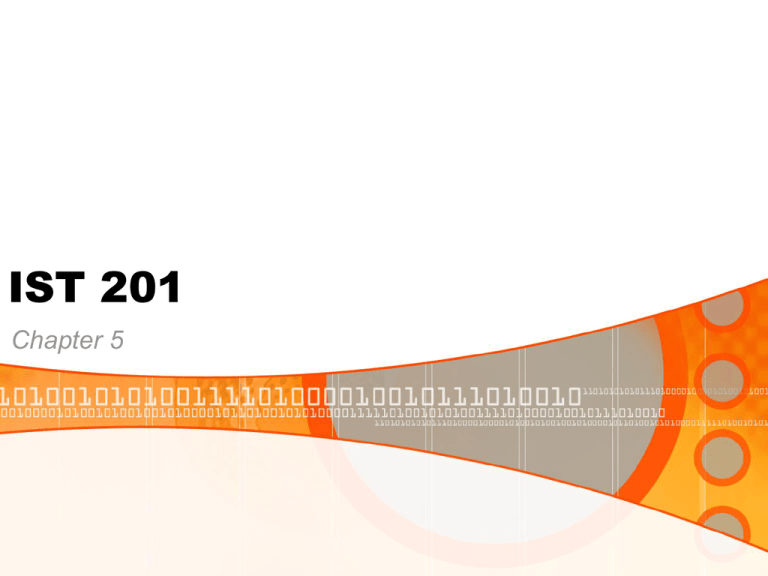
IST 201 Chapter 5 LAN Technologies • Ethernet – most widely used technology in LANS • In 1970, developed and implemented by: • Digital • Intel • Xerox • IEEE 802.3 standard is based on the DIX specification. Ethernet Specifications • • • • • 802.3 – Ethernet 802.3u – FastEthernet 802.3z – Gigabit Ethernet (Fiber) 802.3ab – Gigabit Ethernet (UTP) 802.3ae – 10 Gigabit Ethernet • Layer 1 specification Media • • • • Carries flow of information through a LAN Operates at Layer 1 Cat 5 UTP – primary media in Ethernet networks NIC Ports • RJ45 • AUI – attachment unit interface • 15 pin connector • Unusual • Requires a transceiver to convert to RJ45 UTP Straight Through Cable One end: ow o gw bl blw g brw br One end: ow o gw bl blw g brw br 1 2 3 4 5 6 7 8 Transmit Used for: Switch router Computer switch Computer hub Receive Crossover Cable 1 2 One end: ow o One end: gw g 3 6 Used for: Router router Computer computer Computer router Switch switch Switch hub 3 4 gw bl ow bl 1 4 5 6 7 8 blw g brw br blw o brw br 5 2 7 8 Roll-over Cable 1 2 3 4 5 6 7 8 One end: ow o gw bl blw g brw br One end: br brw g blw bl gw o ow 8 7 6 5 4 3 2 1 Hubs • Multiport repeater • Concentrators – central connection point • Active – has power • re-generates signal & sends out all ports except receiving • Intelligent – active • microchip w/diagnostics • expensive • good for troubleshooting • Passive – no power • connection point • does not regenerate the signal 5-4-3 Rule • No more than 5 segments connect using 4 hubs • Only 3 segments can have hosts • Ensures that the signal reaches the destination within a specified time limit to avoid collisions.. Wireless • RF • Infrared – req line of site • Microwaves • • • • No wires Mobile Versatile Convenient Bridges • Data link layer • Connects network segments • Builds MAC table of hosts on each segment • Filter – looks at the destination MAC address, drops the frame if the destination is on the same segment. • Flood – doesn’t have destination MAC address in the bridge table, sends out all ports except receiving one.. • Forward – picks up frame and forwards out to the correct segment Switch • • • • • • • • Multiport bridge Makes decisions based on MAC address Builds MAC table (switching table) Reduce traffic Increase bandwidth Filter breaks up Flood collision domain Forward NIC • Printed circuit board providing network connectivity • Operates @ layers 1 and 2 but it is considered a layer 2 device • MAC address Peer to Peer Networks • Computers connected to act as equal partners • • • • • No centralized administration Ea. computer may act as a server or client to other computers 10 or fewer Share files Share printers • Easy to install • Does not scale well • Security is low Client/Server • • • • • Centralized control Common admin Increased security Scalable – requires authentication Server – additional processing power RAM • Single point of failure WANs • Networks connected together over a wide geographic area. • Use serial connections • Bits of data are transmitted sequentially over a single channel • • • • Dedicated leased lines ISDN DSL Cable Leased Lines • T1 – 1.544 Mbps • T3 – 44.736 Mbps • Run PPP or Frame Relay Encapsulations • PPP – Point to Point Protocol • Frame Relay ISDN • Integrated Services Digital Network • 128 kbps • Dial on demand connections • BRI (Basic Rate Interface) • 2 B channels (64 kbps bearer channels) - data • 1 D channel (16 kbps delta channel) – signaling and link management • Typically uses PPP encapsulation. DSL • • • • Digital Subscriber Line 128 kbps – 6.1 Mbps Dial-up connectivity Uses telephone infrastructure Cable • Up to 8 Mbps (maybe higher?) • Uses existing cable tv infrastructure • Coaxial cable Router Purpose • Route packets from source to destination with a LAN • Provide connectivity from the LAN to the WAN. • Segments a network into subnetworks • Breaks up broadcast domains. Router WAN Serial Ports • V.35 connectors • DTE (data terminal equipment) – on the customer side of the connection • DCE (data circuit-terminating equipment) on the ISP side. • Provides clock rate • CSU/DSU – channel service unit/data service unit • Another device that provides clocking with a direct connection. Configuring the Router • Need management connection • Roll-over cable/console cable • Connects serial port of computer using DB9 to RJ45 transceiver to Console port (RJ45) on the router • Terminal emulation software • Hyperterminal w/these settings on the COM port • 9600 bps • 8 data bits • No parity • 1 stop bit • None Console v. Auxiliary Port • Console port is used for initial router configuration • Console management connection is between a pc and the router console port. • Management via a modem connection is possible for configuration changes. • Modem is connected to the auxiliary port Cisco 2500 Router • DB-15 port • Requires a transceiver to convert to a Ethernet port (RJ45)
